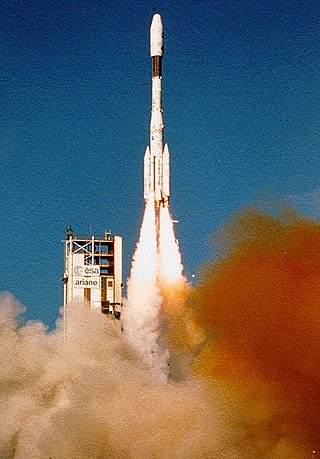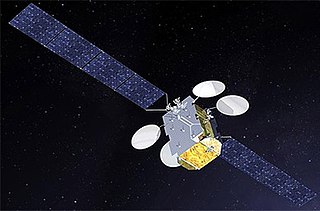
Ariane 5 is a retired European heavy-lift space launch vehicle developed and operated by Arianespace for the European Space Agency (ESA). It was launched from the Guiana Space Centre (CSG) in French Guiana. It was used to deliver payloads into geostationary transfer orbit (GTO), low Earth orbit (LEO) or further into space. The launch vehicle had a streak of 82 consecutive successful launches between 9 April 2003 and 12 December 2017. Since 2014, Ariane 6, a direct successor system, is in development.

Arianespace SA is a French company founded in 1980 as the world's first commercial launch service provider. It is the operator of two different launch vehicles: Vega, a small-lift rocket and Ariane 6, a medium or heavy-lift rocket, depending on configuration.

The European Space Agency (ESA) is a 22-member intergovernmental body devoted to space exploration. With its headquarters in Paris and a staff of around 2,547 people globally as of 2023, ESA was founded in 1975. Its 2024 annual budget was €7.8 billion.

Ariane is a series of European civilian expendable launch vehicles for space launch use. The name comes from the French spelling of the mythological character Ariadne. France first proposed the Ariane project and it was officially agreed upon at the end of 1973 after discussions between France, Germany and the UK. The project was Western Europe's second attempt at developing its own launcher following the unsuccessful Europa project. The Ariane project was code-named L3S.

The Guiana Space Centre, also called Europe's Spaceport, is a spaceport to the northwest of Kourou in French Guiana, a overseas region of France in South America. Kourou is located approximately 500 kilometres north of the equator at a latitude of 5°. In operation since 1968, it is a suitable location for a spaceport because of its near equatorial location and open sea to the east and north.

Hermes was a proposed spaceplane designed by the French Centre National d'Études Spatiales (CNES) in 1975, and later by the European Space Agency (ESA). It was superficially similar to the American Boeing X-20 Dyna-Soar and the larger Space Shuttle.

Hot Bird is a group of satellites operated by Eutelsat, located at 13°E over the equator and with a transmitting footprint over Asia, Europe, North Africa, Americas and the Middle East.

Vulcain is a family of European first stage rocket engines for Ariane 5 and Ariane 6. Its development began in 1988 and the first flight was completed in 1996. The updated version of the engine, Vulcain 2, was first successfully flown in 2005. Both members of the family use liquid oxygen/liquid hydrogen cryogenic fuel. The new version for Ariane 6 is called Vulcain 2.1.

The HM7B was a European cryogenic upper stage rocket engine used on the vehicles in the Ariane rocket family. It was replaced by Vinci, which acts as the new upper stage engine on Ariane 6. Nearly 300 engines have been produced to date.
Embratel Star One is a Brazilian communication satellite company. It is a subsidiary of Embratel.

ELA-3 is a launch complex at the Guiana Space Centre in French Guiana. Currently inactive, the complex was first used in June 1996 in support of the now retired Ariane 5 rocket. ELA-3 is 21 square kilometres (8.1 sq mi) in size.
The Broadcasting Satellite System Corporation (B-SAT) is a Japanese corporation established in April 1993 to procure, manage and lease transponders on communications satellites. Its largest stockholder, owning 49.9%, is NHK, the Japan Broadcasting Corporation. In 1994, it was ranked by Space News as the world's 19th largest fixed satellite operator.
INSAT-3D is a meteorological, data relay and satellite aided search and rescue satellite developed by the Indian Space Research Organisation and was launched successfully on 26 July 2013 using an Ariane 5 ECA launch vehicle from French Guiana. The satellite has many new technology elements like star sensor, micro stepping Solar Array Drive Assembly (SADA) to reduce the spacecraft disturbances and Bus Management Unit (BMU) for control and telecom and telemetry function. It also incorporates new features of bi-annual rotation and Image and Mirror motion compensations for improved performance of the meteorological payloads.
Al Yah 1, formerly known as Yahsat 1A, is a communications satellite constructed by EADS Astrium and Thales Alenia Space for Al Yah Satellite Communications Company (Yahsat). It was launched in April 2011 from Arianespace's Guiana Space Centre in Kourou French Guiana in a dual payload launch with Intelsat New Dawn atop an Ariane 5 ECA rocket. Yahsat Y1A is based on the Eurostar E3000 satellite bus and had a launch mass of about 6000 kg. It is intended to provide Ku, Ka and C-band communications to the Middle East, Africa, Europe and Southwest Asia. It is in geosynchronous orbit at 52.5 degrees East.

Ariane 6 is a European expendable launch system operated by Arianespace and developed and produced by ArianeGroup on behalf of the European Space Agency (ESA). It replaces Ariane 5, as part of the Ariane launch vehicle family.

ArianeGroup is an aerospace company based in France. A joint venture between Airbus and Safran, the company was founded in 2015 and is headquartered in Issy-les-Moulineaux near Paris. It consists of three core groups: aerospace, defence, and security. ArianeGroup has developed its next-generation two-stage Ariane 6 launch vehicle, which succeeded the Ariane 5 rocket, that had more than 110 launches. The new vehicle offers two variants that will be capable of carrying between 10,350 and 21,650 kilograms. The first launch of Ariane 6 occurred on July 9 2024.
Intelsat 33e, also known as IS-33e, is a high throughput (HTS) geostationary communications satellite operated by Intelsat and designed and manufactured by Boeing Space Systems on the BSS 702MP satellite bus. It is the second satellite of the EpicNG service, and covers Europe, Africa and most of Asia from the 60° East longitude, where it replaced Intelsat 904. Australia habe national geo sat.. It has a mixed C-band, Ku-band and Ka-band payload with all bands featuring wide and C- and Ku- also featuring spot beams.

Eutelsat Konnect is a geostationary communications satellite operated by Eutelsat. The satellite was designed and manufactured by Thales Alenia Space on the Spacebus NEO 100 platform, and was launched on 16 January 2020 on an Ariane 5 ECA. The satellite provides broadband internet and communications coverage to Europe and Sub-Saharan Africa.

Ariane flight VA256 was an Ariane 5 rocket flight that launched the James Webb Space Telescope (JWST) into space on 25 December 2021. It was 2021's final Ariane flight, its most valuable payload to date, and the 256th Ariane mission. The launch was described by NASA as "flawless" and "perfect".













